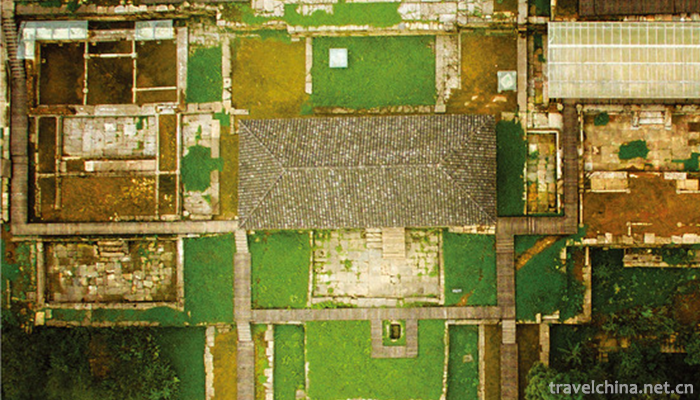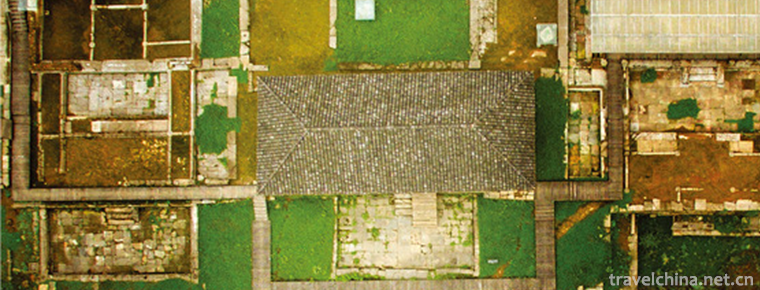Hailongtun Site
Hailongtun Site
Hailongtun is located on the top of Longyan Mountain, about 28 kilometers northwest of Zunyi City, Guizhou Province. It is also called Hailongdun, Longyantun and Longyantun. It is a castle site of Tusi in Song and Ming Dynasties. Its administrative division belongs to the Shuanglong Formation of Hailongtun Village, Gaoping Town, Huichuan District, Zunyi City.
The highest elevation in Tunshang is 1354 meters, and the lowest elevation is 974 meters. The relative elevation difference is about 300-400 meters. Tunding is flat and covers an area of about 1.59 square kilometers. There are nine gates in Tun Shang and six gates in front of Tun Shang: Tong Zhuguan, Tie Zhuguan, Feihuguan, Feilong Guan, Chaotian Guan and Feifengguan, and three gates after Tun Shang: Wan'an Guan, Erdaoguan and Toudaoguan.
Hailongtun was promulgated as a provincial cultural relics protection unit in 1982, promoted to a national key cultural relics protection unit in 2001, and listed in the World Heritage List at the 39th World Heritage Congress on July 4, 2015.
Historical evolution
Traceability
History records show that since the Qin and Han Dynasties, in the southwest of China, including Zunyi (formerly known as Bozhou), the central dynasty has been carrying out the policy of "subjugating foreigners with barbarians", and the territory was handed over to the local officials who paid tribute to the court. In order to maintain its dominant position, Yang Chieftain of Zunyi had three repairs to Hailongtun.
In the thirteenth year of middle school (859), Nanzhao Chief Dragon claimed that the emperor sent troops to occupy Soochow. Annan Capital protects the duplicate broadcasting state.
Tang Yizong Xiantong fourteen years (873 AD), Nanzhao Tusi anti-Tang, seized Soochow.
In the three years of Tang and Qianfu (876 A.D.), Yang Duan, the ancestor of Yang's family in Bozhou, took charge of Bozhou in Taiyuan, Shanxi Province. In order to preserve strength and fight with other tribes, he chose Longya Mountain to send troops.
Evolution
Baoqing three years (1227) in Southern Song Dynasty, Mongolia destroyed Xixia, Duanping first year (1234) combined with Song Dynasty destroyed Jin. After the extinction of gold, Mongolia and the Southern Song Dynasty began to face a positive conflict. The strategy adopted by Mongolia to bypass the Southern Song Dynasty from the west to the East made Sichuan and Chongqing the first place to fight frequently.
In the second year of Chunyou in the Southern Song Dynasty (1242), Yu Yu Yu was appointed as the placator of Sichuan Province, presiding over the defense of Sichuan Province, and publicizing his contributions.
In the fifth year of Baoyou in Southern Song Dynasty (1257), Lu Wende and Yang Wenyi, the envoys of the two governments, built a new city of Longyan because they thought it was the foundation of Bozhou. Longyan is now Hailongtun, so it is generally believed that Hailongtun was built in 1257. (The Stele of Yang Wen's Shinto)
Baoyou in Southern Song Dynasty (1258) first month, the Southern Song Dynasty sent Lufengnian Shu to supervise the Pass and Tungao affairs in Bozhou and other places.
In the first year of Kaiqing in Southern Song Dynasty (1259), Montgomery Khan died in the battle of Diaoyu City, which had a great impact on the later historical trend. All these are closely related to the positive advice and experience of Bozhou people.
In the first year of Wanli in Ming Dynasty (1573 A.D.), Yang Yinglong inherited the mission of propaganda envoy in Bozhou.
After the seventeen years of Wanli (1589 A.D.), Yang Yinglong adopted a two-handed strategy, making friends and attacking close, repairing the upper court and the court without major contradictions and conflicts of interests with the Ming Dynasty, and was often rewarded by the court. The privilege of Tusi was exercised downwards, which intensified the contradictions within Bozhou.
In the 24th year of Wanli in Ming Dynasty (1596 A.D.), Yang Yinglong, the Tusi of Yang's 29th generation, mobilized 80,000 servicemen and craftsmen and spent four years expanding castles and palaces on the basis of Longya Tun built by his ancestors, building 12 gates around them and building huge fortresses on mountains within 5 square kilometers. Buildings are built with jacks of huge stones. The gates are inscribed with the names of the gates. Arrow towers, warehouses, barracks and water jails are built on the gates. The stone walls between the gates are facing each other.
In the twenty-seventh year of Wanli (1599) of the Ming Dynasty, Yang Yinglong was consoled by the propaganda of Bozhou, and the court urgently sent 240,000 troops to eight routes. In the following year, Hailongtun was defeated and Bozhou (now Zunyi, Guizhou, to northern Guizhou) was calmed down. It lasted 114 days and was historically known as the Battle of Pingbo.
In February of the 28th year of Wanli in the Ming Dynasty (1600), Governor Li Hualong led the Eighth Route Army to broadcast it on the air. In mid-April, he joined Hailongtun, where a bloody battle began. On June 6, Hailongtun was attacked and Yang Yinglong hanged himself.
In the 20th year of Wanli (1601 A.D.), the Ming court abolished the Tusi system in Bozhou, appointed by the central government, and exchanged with local officials. It declared the end of the hereditary Tusi system of Yang surname, which ruled Bozhou for 725 years. From then on, the curtain of the "Turkish Return" in the Tusi area of the whole country was opened.
Repair history
In 1999, the Zunyi Municipal People's Government allocated funds to repair the 36-step ladder at Feihuguan.
In April 2002, Guizhou Cultural Relics Conservation Research Center compiled the Design Plan of Hailongtun Conservation and Reinforcement Project in Zunyi, Guizhou.
In September 2004, Shaanxi Institute of Ancient Architecture was entrusted with the preparation of Hailongtun Cultural Relics Protection Plan.
On September 10, 2005, the upper division of Hailong Tun was managed by the Huichuan District People's Government.
From February to September 2007, the people's government of Huichuan District carried out rescue maintenance on the city wall between Tongzhuan Pass and Tiezhuguan Pass in Hailongtun.
In 2008, the collapsed rocks of Xiamatai and Feihuguan in Hailongtun were cleaned up, and waterways, Feihuguan wooden bridge and tourist trails were repaired.
In 2009-2010, the Feihuguan renovation project was implemented, and the Feihuguan was renovated as a whole.
In March 2012, the declaration of the Tusi Site at Hailongtun in Huichuan District for World Cultural Heritage was launched.
From 2014 to 2015, the cultural relics such as Tongzhuguan, Tiezhuguan, Wan'anguan, Xiguan, Houguan, Watchtower, Haichao Temple and Ming Dynasty architectural sites were renovated.
Visiting reference
Climate
Zunyi, where Hailongtun is located, is located in the humid area of the middle subtropical monsoon climate. Like most areas of Guizhou Province, there is no severe cold in winter and no severe heat in summer. The annual average temperature is between 13 and 18 degrees Celsius, with abundant rainfall and sunshine. The warm and humid climate makes Zunyi a tourist attraction, and the tourism suitability of its climate resources is rare in China.
Optimum travel time
Due to the climatic characteristics of Zunyi, Hailongtun can be visited all the year round.
Traffic profile
The fare is 5 yuan for the bus from Maotaopu to Gaoping, and 10 yuan for the special line bus from Gaoping to Hailongtun, which can be reached in about 20 minutes.


-
1.Alipay
Alipay (China) Network Technology Co., Ltd. is the third party payment platform in China. It is committed to providing a simple, safe and fast payment solution
Time 2018-11-13 -
2.Tourist Hall of Shanghai Global Financial Center
Shanghai Global Financial Center is located at 100 Century Avenue, Pudong New Area, Shanghai. It is a skyscraper located in Lujiazui Financial and Trade Zone. It faces the hinterland of Pudong New Are
Time 2018-12-19 -
3.Asihatu Stone Forest
Chaihe Tourist Scenic Spot has a total area of 1368.7 square kilometers, which is a national 5A tourist scenic spot. The area of Alshan City in Xing'an League is 7408.7 square kilometers, and Chaihe T
Time 2019-01-02 -
4.Haikou Arcade Street
The old arcade street in Haikou is one of the most distinctive Street landscapes in Haikou. Four of the oldest buildings were built in the Southern Song Dynasty
Time 2019-02-07 -
5.Legend of Badaling Great Wall
Badaling Great Wall legend is one of the traditional folk legends in Beijing. It is rooted in the folk and has prominent dialect characteristics. It combines romanticism and realism skillfully.
Time 2019-04-02 -
6.End drum cavity
Weishan Lake Drum Tune, also known as Duangong Tune, is a traditional folk art of the Han nationality originating in Weishan County and Dongping County of Shandong Province
Time 2019-04-28 -
7.River chant
River chant is a traditional folk song spread in the Yellow River and the Yangtze River valley. In ancient times, when people were fighting with nature, they shouted; when harvesting
Time 2019-05-05 -
8.Luonan Jing Blackboard
In 2011, Luonan Jingbanshu was approved by the State Council and listed in the third batch of national intangible cultural heritage list. As early as in the Daoguang period of the Qing Dynasty (around
Time 2019-05-15 -
9.Zhangjiajie Yangxi Opera
Zhangjiajie Yangxi Opera originated in the middle of Qing Dynasty and has a history of more than 300 years. It belongs to Beilu Yangxi Opera. The singing feature is the singing method of "golden
Time 2019-07-16 -
10.Panzhihua famous specialty
The snacks in Panzhihua are mainly Sichuan flavor. The most popular snack in Panzhihua is mutton rice noodles. The rice noodles cooked by pure mutton soup, together with bean paste, pepper, millet and other seasonings, have a unique and representative flavor
Time 2020-12-14 -
11.Suining first industry
In 2019, the total output value of agriculture, forestry, animal husbandry and fishery in Suining will reach 30.998 billion yuan, an increase of 3.4% over the previous year.
Time 2020-12-16 -
12.Meishan Sports
In 2019, 45 games will be held and 30000 people will participate in the games. At the end of the year, there were 116 sports associations. By the end of the year, there were 1410 sports venues in the education system. Meishan post and telecommunication
Time 2020-12-18